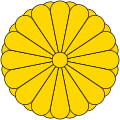Emperor Monmu
| Emperor Monmu 文武天皇 | |||||
|---|---|---|---|---|---|
 | |||||
| Emperor of Japan | |||||
| Reign | 697–707 | ||||
| Enthronement | September 23, 697 | ||||
| Predecessor | Jitō | ||||
| Successor | Genmei | ||||
| Born | Karu (珂瑠 or 軽) 13 October 683 | ||||
| Died | 18 July 707 (aged 23) Fujiwara-kyō, Japan | ||||
| Burial | Hinokuma no Ako no oka no e no misasagi (檜隈安古岡上陵) (Nara) | ||||
| Issue |
| ||||
| |||||
| House | Imperial House of Japan | ||||
| Father | Prince Kusakabe | ||||
| Mother | Empress Genmei | ||||
Emperor Monmu (文武天皇, Monmu-
Monmu's reign spanned the years from 697 through 707.[3]
Traditional narrative
Before his ascension to the
He was a grandson of Emperor Tenmu and Empress Jitō. He was the second son of Prince Kusakabe. Monmu's mother was Princess Abe, a daughter of Emperor Tenji. Monmu's mother would later accede to the throne herself, and she would be known as Empress Genmei.[6]
Events of Monmu's life
Karu-shinnō was only six years old when his father,
- 697: In the 10th year of Jitō-tennō's reign (持統天皇十年), the empress abdicated; and the succession (senso) was received by a grandson of Emperor Tenmu. Shortly thereafter, Emperor Monmu is said to have acceded to the throne (sokui).[7]
Emperor Monmu ruled until his death in 707, at which point he was succeeded by his mother,
Emperor Monmu's reign lasted 10 years. He died at the age of 25.[8]
The actual site of Monmu's
(misasagi) at Nara.The Imperial Household Agency designates this location as Monmu's mausoleum. It is formally named Hinokuma no Ako no oka no e no misasagi.[9]
Kugyō
In general, this elite group included only three to four men at a time. These were hereditary courtiers whose experience and background would have brought them to the pinnacle of a life's career. During Monmu's reign, this apex of the Daijō-kan included:
- Daijō-daijin, Osakabe-shinnō.[5]
- Sadaijin
- Udaijin
- Naidaijin, Nakatomi Kamako no Muraji.[10]
- Dainagon, Fujiwara Fuhito.[11]
Eras of Monmu's reign
Conventional modern scholarship seems to have determined that the years of Monmu's reign are encompassed within more than one
- Taihō (era) (701–704)
- Keiun (704–708)
Non-nengō period
The initial years of Monmu's reign are not linked by scholars to any era or nengō.[13] The Taika era innovation of naming time periods – nengō – languished until Monmu reasserted an imperial right by proclaiming the commencement of Taihō in 701.
- See Japanese era name – "Non-nengo periods"
- See Monmu period (697–701).
In this context, Brown and Ishida's translation of Gukanshō offers an explanation about the years of Empress Jitō's reign which muddies a sense of easy clarity in the pre-Taiho time-frame:
- "The eras that fell in this reign were: (1) the remaining seven years of Shuchō [(686+7=692?)]; and (2) Taika, which was four years long [695–698]. (The first year of this era was kinoto-hitsuji [695].) ... In the third year of the Taka era [697], Empress Jitō yielded the throne to the Crown Prince."[5]
Consorts and children
Bunin: Fujiwara no Miyako (藤原宮子, d. 754), Fujiwara no Fuhito’s daughter
- First Son: Prince Obito (首皇子) later Emperor Shōmu
Hin: Ki no Kamado-no-iratsume (紀竃門娘)
Hin: Ishikawa no Tone-no-iratsume (石川刀子娘)
- Takamado Hironari (Hiroyo)
See also
- Emperor of Japan
- List of Emperors of Japan
- Imperial cult
- Taihō Code
Notes

- ^ a b Imperial Household Agency (Kunaichō): 文武天皇 (42); retrieved 2013-8-22.
- ^ Ponsonby-Fane, Richard. (1959). The Imperial House of Japan, p. 55.
- ^ Titsingh, Isaac. (1834). Annales des empereurs du Japon, pp. 60–63, p. 63, at Google BooksBrown, Delmer M. (1979). Gukanshō, pp. 270–271; Varley, H. Paul. (1980). Jinnō Shōtōki. pp. 137–140.
- ^ Brown, pp. 264; prior to Emperor Jomei, the personal names of the emperors were very long and people did not generally use them. The number of characters in each name diminished after Jomei's reign.
- ^ a b c Brown, p. 270.
- ^ Varley, p. 138.
- ^ Titsingh, p. 60; Brown, p. 270; Varley, pp. 44, 137–138; a distinct act of senso is unrecognized prior to Emperor Tenji; and all sovereigns except Jitō, Yōzei, Go-Toba, and Fishimi have senso and sokui in the same year until the reign of Emperor Go-Murakami.
- ^ Varley, p. 140.
- ^ Ponsonby-Fane, p. 420.
- ^ Brown, p. 266.
- ^ Brown, p. 271.
- ^ Titsingh, pp. 60–63; Brown, p. 271.
- ^ Titsingh, p. 60.

